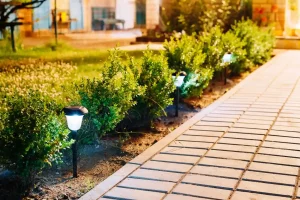Outdoor lighting has shifted from simple illumination to landscape lighting design that blends artistry, safety, and sustainability. In 2025, expect cutting‑edge tech—think app‑controlled low‑voltage systems and materials that literally glow after sunset—to redefine curb appeal.
The Top 10 Innovations for 2025
| # | Innovation | Why It Matters & How to Use It |
| 1 | Minimalist, Glare‑Free Fixtures | Sleek housings tuck light sources out of sight, reducing light pollution and highlighting architecture for true “less‑is‑more” aesthetics. Sterling Lighting |
| 2 | Smart Mesh‑Network Controls | Fixtures talk to one another, auto‑balancing brightness and schedules via Bluetooth‑Low‑Energy hubs—perfect for complex landscape lighting design. Sterling Lighting Lumary |
| 3 | Tunable‑White & RGBW LEDs | Dial color temperature from warm 2700 K to cool 5000 K or splash party colors—all from your phone. Lumary |
| 4 | Solar‑Charged Path Lights with 12‑hr Batteries | New panels + LiFePO₄ cells keep LED pathway lights glowing till dawn—no wiring needed. Real Simple |
| 5 | Permanent Addressable Eave Strips | Low‑profile RGB strips hide under gutters, giving year‑round “holiday‑on‑demand” effects you can theme by season. Lumary |
| 6 | Moon‑Light‑Mimic Down‑Lighting | High tree‑mounted spots cast soft silver light, replicating natural moon glow for patios and lawns. nvlightingga.com |
| 7 | Glow‑in‑the‑Dark Concrete & Pavers | Photoluminescent aggregates charge by day, providing off‑grid walkway guidance at night—zero energy cost. nvlightingga.com |
| 8 | Fire‑&‑Water Hybrid Fixtures | Combine bio‑ethanol flames with underwater LEDs for dramatic poolside focal points. nvlightingga.com |
| 9 | Low‑Voltage Micro‑Bollards | 3‑watt bollards deliver full‑cutoff beams only where needed—ideal for low‑voltage outdoor lights along drives. Sterling Lighting |
| 10 | Dark‑Sky Adaptive Dimming | Integrated sensors lower output after midnight, protecting stargazing and wildlife while saving energy. Sterling Lighting |
Design Tips for Cohesive Lighting
1. Layer it: Blend ambient, task, and accent sources.

2. Voltage mix: Pair 12 V low‑voltage runs for paths with 120 V smart sconces at entries.
3. Match Kelvin temps: Keep all fixtures 2700‑3000 K for warm hospitality unless purposeful contrast is desired.
4. Hide hardware: Recess transformers and conduit in planting beds for a distraction‑free garden.

Installation & Safety Quick Start
● Plan voltage drops: Keep 12 V runs under 100 ft or use heavier gauge wire.
● GFCI everywhere: Mandatory for 120 V exterior circuits.
● Weather ratings: IP65 minimum; IP67 for fixtures near pools or sprinklers.
● Code check: Confirm local bylaws on lumen caps and dark‑sky compliance.

Maintenance Best Practices
Task | Frequency |
Clean lenses & solar panels | Monthly |
Tighten mounting screws | Seasonally |
Inspect gaskets & seals | Annually |
Firmware‑update smart hubs | As released |
Frequently Asked Questions
Yes—look for wet‑rated LEDs (IP65 +) and temperature ranges down to ‑40 °C. LEDs are vibration‑resistant and thrive in cold weather, actually performing more efficiently.
Cold actually extends LED lifespan; just verify fixtures have moisture‑blocking gaskets and conformal‑coated drivers for freeze‑thaw cycles.
Choose UV‑resistant cable jackets, shatter‑resistant LEDs, and linkable strands rated for at least IP44; smart versions let you schedule color scenes.
Ready to modernize your nightscape? Book a complimentary design consult and we’ll craft a custom low‑voltage layout using these 2025 innovations.



